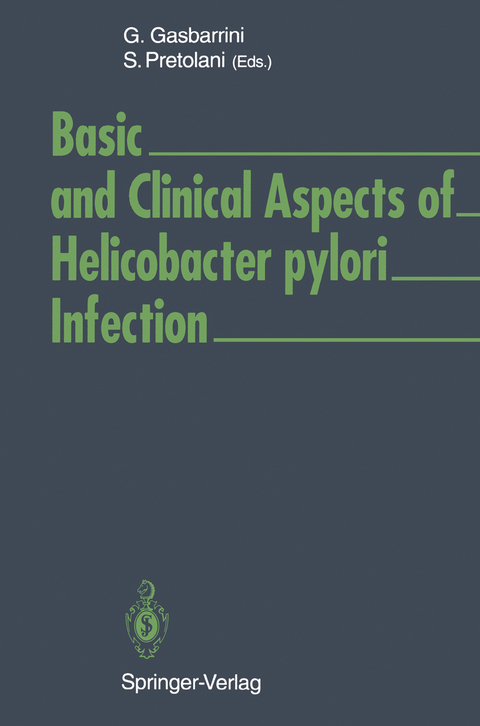
Basic and Clinical Aspects of Helicobacter pylori Infection
Springer Berlin (Verlag)
978-3-642-78233-6 (ISBN)
Nonulcer Dyspepsia.- Nonulcer Dyspepsia.- Nonulcer Dyspepsia: Psychological Considerations.- Nonulcer Dyspepsia and Helicobacter pylori: Effect of Eradication on Symptoms and Gastritis.- Upper Gastrointestinal Endoscopy and the Prevalence of Helicobacter pylori Infection in Recurrent Abdominal Pain of Childhood.- The Value of Serodiagnosis of Helicobacter pylori in Predicting Negative Gastroscopy.- The Icelandic Nonulcer Dyspepsia/Helicobacter pylori Study: Symptomatic Response and Eradication Rate with De-Nol or De-Nol Plus Metronidazol in Treatment of Helicobacter-Positive Patients with Nonulcer Dyspepsia.- Long-Term Follow-up of Children with Helicobacter pylori-Associated Nonulcer Dyspepsia After Eradication of the Infection.- Helicobacter pylori, Surgery, and Aging.- The Role of Ulcer Surgery Today.- Effect of Single-Shot Antibiotic Treatment on Helicobacter pylori in Patients Undergoing Ulcer Operation.- The Aging Stomach.- Pathogenic Mechanisms of Helcobacter pylori Infection: Virulence.- Construction of a Molecular Population GeneticFramework for the Characterization ofHelicobacter pylori Pathogenesis by Multilocus Enzyme Electrophoresis.- The Flagella of Helicobacter pylori: Molecular Analysis and Potential in Pathogenesis.- Identification of Potential S Layer Proteins of Helicobacter pylori.- Urease as a Colonisation Factor in Helicobacter.- Affinity and Ion Exchange Chromatography in the Purification and Characterization ofHelicobacter pylori Cytotoxin-Associated Proteins.- Neutralization of the Vacuolating Toxin from Helicobacter pylori by Antisera from Patients with Duodenal or Gastric Ulcer.- Helicobacter pylori: PhosphoHpase C and Haemolysis.- Haemaglutinins ofHelicobacter pylori and Adherence to HEp-2 Cells.- Partial Purification and Characterization ofSialic Acid Specific Soluble Haemagglutinin(s) of Helicobacter pylori Strain NCTC 11637.- Pathogenic Mechanisms of Helicobacter pylori Infection: Host Response.- The Role of Helicobacter pylori Gastritis in Ulcerogenesis and Carcinogenesis.- Isolation and Phenotypical Characterization of T-Lymphocytes Isolated from the Gastric Mucosa of Patients With and Without Helicobacter pylori.- Demonstration of the Major Cytotoxin-Association Protein of Helicobacter pylori in Gastric Biopsies by Western Blotting.- Gastric Functions and Helicobacter pylori Infection in Patients with Fundic Atrophic Gastritis.- Peptic Ulcer in the Elderly: Not a Helicobacter-RelatedCondition?.- Serology of Helicobacter pylori Infection.- The Use of Helicobacter pylori Serology in Diagnosis and Treatment Monitoring.- The Use of Serological Detection of Helicobacter pylori in Epidemiology.- Helicobacter pylori Serology: Kit Evaluation and Comparison.- Standards for Serologic Study of Infection with Helicobacter pylori.- Helicobacter pylori Antigenic Preparations.- The Value of Class and Subclass ELISAs and Antibody Specificity in Monitoring Treatment of Helicobacter pylori.- Future Prospects for Helicobacter pylori Serology.- TheHelicobacter pylori San Marinq Study: Seroepidemiology of Helicobacter pylori Infection in the Republic of San Marino.- Molecular Biology of Helicobacter pylori.- Construction of Isogenic Mutants of Helicobacter pylori Deficient in Urease Activity.- Cloning of a Helicobacter pylori Flagellin Gene and Construction of a Nonflagellated Mutant by Transformation-Mediated Allelic Exchange.- Identification and Characterization of an Adhesion Gene of Helicobacter pylori by Cloning.- Molecular Cloning and Nucleotide Sequence Determination of htrA, a Gene Encoding a 48-kDa Stress Protein of Helicobacter pylori.- Diagnosis of Helicobacter pylori in Gastric Juice Aspirates Using Polymerase Chain Reaction.- Molecular Fingerprinting of Helicobacter pylori: An Evaluation of Methods.- Developments in Ribotyping of Helicobacter pylori.- The 130-kDa Vacuolating Cytotoxin-Associated Protein Is a Component of Cytotoxic Helicobacter pylori Organisms.- The Cloning and Partial Sequence Analysis of the Catalase Gene of Helicobacter pylori.- Binding of Helicobacter pylori to Extracellular Matrix Proteins.- Therapeutic Approaches.- Helicobacter pylori: Clinical Aspects.- H2 Receptor Antagonists: Is There a Place in the Treatment of Helicobacter pylori Infection?.- Proton Pump Inhibitors in the Management of Helicobacter pylori-Related Diseases.- Pharmacology of Bismuth-Containing Medicines Used to Treat Helicobacter pylori Infections.- Bismuth and Helicobacter pylori.- Antibiotics in Helicobacter pylori Treatment.- Clinical Application of Antibiotics in Eradicating Helicobacter pylori.- Cytoprotective Drugs and Helicobacter pylori Infection.- Approaches to the Treatment of Helicobacter pylori Infection.
| Erscheint lt. Verlag | 19.1.2012 |
|---|---|
| Zusatzinfo | XIII, 313 p. |
| Verlagsort | Berlin |
| Sprache | englisch |
| Maße | 155 x 235 mm |
| Gewicht | 498 g |
| Themenwelt | Medizinische Fachgebiete ► Chirurgie ► Viszeralchirurgie |
| Medizinische Fachgebiete ► Innere Medizin ► Gastroenterologie | |
| Medizin / Pharmazie ► Medizinische Fachgebiete ► Mikrobiologie / Infektologie / Reisemedizin | |
| Schlagworte | Antibiotic • Antibody • Antigen • biopsy • Dyspepsia • Endoscopy • gastric carcinoma • Gastritis • Gastroduodenale Pathologie • gastroduodenal pathology • Gene • Helicobacter pylori • Helicobacter pylori / Campylobacter pylori • Infection • Molecular Biology • pathogenesis • Stomach • Surgery |
| ISBN-10 | 3-642-78233-7 / 3642782337 |
| ISBN-13 | 978-3-642-78233-6 / 9783642782336 |
| Zustand | Neuware |
| Haben Sie eine Frage zum Produkt? |
aus dem Bereich


